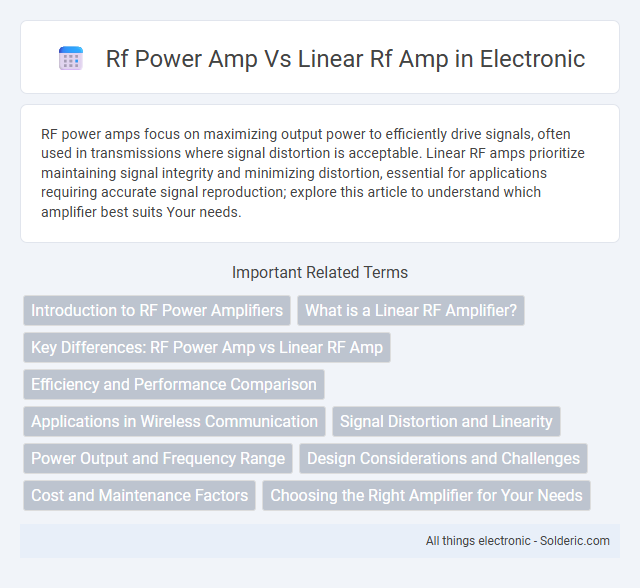RF power amps focus on maximizing output power to efficiently drive signals, often used in transmissions where signal distortion is acceptable. Linear RF amps prioritize maintaining signal integrity and minimizing distortion, essential for applications requiring accurate signal reproduction; explore this article to understand which amplifier best suits Your needs.
Comparison Table
| Feature | RF Power Amplifier | Linear RF Amplifier |
|---|---|---|
| Primary Function | Boosts RF signal power for transmission | Amplifies RF signals while preserving waveform linearity |
| Linearity | Non-linear, optimized for maximum output power | High linearity, minimizes distortion and intermodulation |
| Efficiency | High efficiency, typically Class C or D amplifiers | Moderate efficiency, commonly Class A or AB amplifiers |
| Applications | RF transmission in broadcasting, radar | RF communication systems requiring signal integrity like LTE, 5G |
| Output Power | High output power capability | Moderate output power with accuracy |
| Distortion | Higher distortion due to non-linearity | Low distortion, maintains signal fidelity |
| Cost | Generally lower cost | Higher cost due to complexity |
Introduction to RF Power Amplifiers
RF power amplifiers boost radio frequency signals to higher power levels for transmission, crucial in wireless communication systems. Linear RF amplifiers maintain signal integrity by preserving waveform linearity, ideal for complex modulation schemes, while standard RF power amplifiers prioritize efficiency and power output. Your choice depends on the application's need for signal fidelity versus power efficiency.
What is a Linear RF Amplifier?
A linear RF amplifier is designed to amplify radio frequency signals while preserving the original waveform's amplitude and phase, ensuring minimal distortion. These amplifiers operate within the linear region of their transfer characteristic to maintain signal integrity, which is crucial for applications like communication systems and signal testing. Unlike power RF amplifiers that prioritize maximum output power, linear RF amplifiers balance gain with fidelity for accurate signal reproduction.
Key Differences: RF Power Amp vs Linear RF Amp
RF power amplifiers primarily focus on delivering high output power with efficiency, making them ideal for transmitting signals over long distances. Linear RF amplifiers emphasize signal fidelity by maintaining linearity across the output range, essential for applications requiring minimal distortion such as in complex modulation schemes. The key difference lies in their operation: power amplifiers prioritize power gain and efficiency, while linear amplifiers ensure signal integrity and linear amplification.
Efficiency and Performance Comparison
RF power amplifiers typically offer higher efficiency due to their design focused on maximizing output power with minimal energy loss, making them ideal for applications requiring strong signal transmission. Linear RF amplifiers prioritize signal fidelity and linearity, ensuring minimal distortion and better performance in complex modulation schemes, but generally operate with lower efficiency. Balancing efficiency and performance depends on the specific application requirements, with power amplifiers suited for high output power and linear amplifiers favored for high-quality, precise signal amplification.
Applications in Wireless Communication
RF power amplifiers are essential in wireless communication for boosting signal strength to cover extensive areas, ensuring reliable transmission in cellular base stations and broadcast systems. Linear RF amplifiers maintain signal integrity with minimal distortion, making them ideal for applications like LTE and 5G where complex modulation schemes require high linearity. Choosing between RF power amps and linear RF amps depends on balancing output power needs with the linearity demands of specific wireless communication protocols.
Signal Distortion and Linearity
RF power amplifiers prioritize maximizing output power but often introduce signal distortion due to non-linear operation, affecting signal fidelity. Linear RF amplifiers maintain signal integrity with minimal distortion by operating within their linear region, ensuring high linearity and accurate amplification of complex modulation schemes. Choosing between the two depends on application requirements where linearity is crucial for communication systems using QAM or OFDM modulation.
Power Output and Frequency Range
RF power amplifiers deliver high power output ideal for transmission applications, while linear RF amplifiers prioritize signal fidelity and operate efficiently within moderate power levels. Power output for RF power amps can exceed hundreds of watts, supporting high-frequency ranges up to several GHz, suitable for broadcasting and radar systems. Linear RF amplifiers maintain linearity across a broad frequency range, typically from tens of MHz to a few GHz, optimizing performance in communication systems that require minimal signal distortion.
Design Considerations and Challenges
Design considerations for RF power amplifiers emphasize maximizing efficiency and output power, often leading to nonlinear operation that causes signal distortion. Linear RF amplifiers prioritize signal fidelity, requiring complex biasing and feedback mechanisms to maintain linearity while managing heat dissipation and power consumption. Challenges in balancing efficiency with linearity include addressing intermodulation distortion, thermal management, and amplifier stability across varying frequencies and load conditions.
Cost and Maintenance Factors
RF power amplifiers typically have lower initial costs but may require more frequent maintenance due to higher heat generation and component stress. Linear RF amplifiers, while generally more expensive upfront, offer better signal fidelity and longer lifespan, reducing long-term maintenance expenses. Your choice depends on balancing budget constraints with desired reliability and performance in your application.
Choosing the Right Amplifier for Your Needs
Selecting between an RF power amplifier and a linear RF amplifier depends primarily on your application requirements, such as efficiency versus signal fidelity. RF power amplifiers excel in delivering high output power with greater efficiency, making them ideal for applications like broadcasting and radar where signal linearity is less critical. Linear RF amplifiers maintain signal integrity and low distortion, crucial for communication systems needing high-quality modulation and minimal signal degradation.
rf power amp vs linear rf amp Infographic

 solderic.com
solderic.com